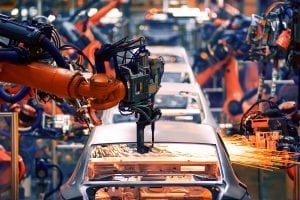What Does Lean Manufacturing Look Like in a Connected Worker World?
“Something is wrong if workers do not look around each day, find things that are tedious or boring, and then rewrite the procedures. Even last month’s manual should be out of date.” -Taiichi Ohno, father of the Toyota Production System, precursor to Lean manufacturing
According to Lean.org, “a Lean organization understands customer value and focuses its key processes to continuously increase it. The ultimate goal is to provide perfect value to the customer through a perfect value creation process that has zero waste.”
It’s no surprise, then, that companies have sought to embrace and operate by the Lean philosophy for decades.
To understand how companies can apply Lean manufacturing techniques to eliminate waste from the production process and improve operational and business outcomes, it’s useful to contrast what organizations have to work with in order to deploy Lean manufacturing. Usually, it’s either through manual, paper-based and siloed means or technology that digitizes, executes, measures and transforms industrial work, like a Connected Worker Platform.
First, here’s a summary of the five Lean principles as it applies to manufacturing. While there are many variations, the American Society of Mechanical Engineers sets it up well. Its list includes the following:
- Identify Value – This principle is about making sure companies have really studied what their customers define as the real value of the work they do. This includes knowing what your product is used for, what value it creates, what your customers expect it should cost, and how often it is expected to change over time.
- Map the Value Stream – This principle is about mapping the entire value chain, from sourcing raw materials through to delivering the final value of your product. This map is used for the purpose of eliminating any step that does not add value.
- Create Flow – Once non-value adding steps have been eliminated, flow is about removing any delays, waits or bottlenecks that could occur when different parts of the process have different capacities.
- Establish Pull – Pull is about embracing Just-In-Time (JIT) manufacturing to ensure you don’t create excess inventory, which is a form of cost and waste.
- Seek Perfection – This lofty-sounding principle is all about making Lean manufacturing stick where every employee embraces it and takes ownership of making it happen. This principle recognizes that systems are not static, and an organization that practices Lean manufacturing will constantly change and adjust in order to remain current and effective.
Now let’s take a look at how these principles could be enhanced through the use of a modern, digital platform that’s purpose-built to improve productivity, quality and safety throughout the organization.
Identify value
To do this right, it is an exhaustive exercise no matter how you slice it or what tools are available. The Lean Way talks about this step as understanding what the customer is willing to pay for. Many companies produce things where their customers create the real value from their product by including it with several other components. The value of their solution in and of itself may not have been fully appreciated.
While a Connected Worker Platform does not directly help a company identify the value of its products, it indirectly helps uncover the value. When workers are empowered with a comprehensive view of the entire process and the data it creates, broken parts of the process quickly surface and point to areas that certainly don’t add value to the company or customer. Here, the process may capture non-value adding steps the customer has to take to make use of the product, or inefficient production methods that add to the cost of the product. Having said this, companies still need to use manual means to comprehensively gather requirements from the customer to ensure they are meeting or exceeding those requirements.
Map the value stream
There are many manual approaches to mapping the value stream, several of which have been cataloged by the American Society for Quality. There are also many very similar techniques that emerged from the 1990s’ “process reengineering” era, including the Rummler-Brache Process Relationship Map.
Still, today this act of discovery and cataloging is largely variations of flowcharts, with the addition of some online tools for creating them. Business Process Management (BPM), the systematic orchestration of processes through visual languages, application programming interfaces (APIs) and rules engines, has found a second life in Robotic Process Automation (RPA), which takes BPM to the next level with codeless tools better able to build routines on the fly and bring disparate systems together.
None of these approaches, however, really achieve the full value map that Lean manufacturing envisions. Connected Worker technologies come closer by pearling together the processes that humans (and some machines) orchestrate, in a simple and declarative way, into mega-chains that can depict end-to-end value.
Data about the process that these Connected Worker technologies automatically collect shows what resources are being used and reveals the non-value-adding steps, or no value adds (NVAs), as Lean refers to them, that is the core of what Lean manufacturing is meant to achieve.
Once a new value stream map (VSM) has been created, Connected Worker technologies can help companies ensure that the new process is being followed.
The Holy Grail of value stream mapping, however, is still some time off. This is where dynamic processes that involve humans and machines can be depicted and manipulated visually, and waste, errors, and bottlenecks can be seen in real-time. The closest step toward the Holy Grail available today is probably the Japanese concept of the Andon board. Andon boards are widely deployed in modern factories and visually depict where the process and, therefore, value is breaking down in industrial settings. Andon boards of human processes can be derived from the data collected by Connected Worker technologies.
Create flow
Connected Worker technologies really excel with the flow principle because they record everything about a process, including where it is failing. The previous method for collecting such data was a time and motion study, which were generally as simple as action and time data collected by an engineer with a stopwatch. This represented only a sampling of the work. Connected Worker technologies, however, timestamp every action so all of the work can be measured in real time. Through the data collected, gaps and bottlenecks pointing to the biggest losses easily surface. It becomes easier to identify what machines are idle, what stations aren’t configured well, and what human capital is being squandered waiting for the next task.
Establishing pull
The core of pull is really Just-in-Time (JIT) manufacturing. Although Toyota pioneered JIT in the 1970s, it still eludes many manufacturers today.
Quality and Innovation reported that lack of visibility keeps 84% of chief supply chain officers up at night, and 87% of chief supply chain officers reported that managing supply chain disruptions proactively is still a big problem – a core skill to do JIT well. This survey also revealed that 4/5ths of the data required to provide the visibility is still siloed, “dark” or otherwise unavailable to be analyzed.
Another moniker being applied to make JIT possible is the concept of an extended value chain. While this sounds promising, what companies really need to do to truly establish pull is to bring the customer into the process. This clearly happens in retail, but shortages known as stockouts are still quite pernicious, amounting to an estimated 1 trillion dollars of lost sales in 2018.
Connected Worker technologies, nonetheless, tighten every point in a work process. This reduces changeovers and increases overall flexibility, which allows companies to be efficient enough to reduce minimum order quantities, which, in turn, reduces inventory. To improve pull, Connected Worker technologies can include the customer in procedures that could then trigger demand for a manufacturer’s supply. This fully extended view of the supply chain is generally still a nascent concept beyond basic demand signals like a retailer reordering shampoo or a car company tightly tracking sales trends. Demand signals could now be extended to specific processes now, like completing a specific batch or run of product.
Seek perfection
Modern tools and techniques like Connected Worker technologies really shine in helping companies “seek perfection,” as they really bring the worker into the process as an owner. A worker may own a part of a process or the whole process. Or they may just take advantage of such tools to submit feedback. Traditional approaches to procedures and training fall short here; employees forgot what they were trained on, manuals weren’t kept current, and there was no accountability to act on feedback provided. Companies talked about putting in the time on Lean manufacturing without really embracing continuous improvement.
By contrast, if a connected worker can own the work and make changes to it with little or no friction, there is a sense of ownership. Connected Worker technologies then ensure there is no backsliding, by locking in a new best practice and ensuring that the new process is adhered to. Each step forward becomes a permanent gain.
While Lean is now 30 years old, its principles are still incredibly relevant in addressing today’s operational challenges. What were once a daunting set of tasks for all but the best companies when Lean manufacturing first surfaced now seem like actions within the grasp of most companies, provided they modernize how they orchestrate work. Connected Worker technologies provide the means for most manufacturers to finally make work Lean.





